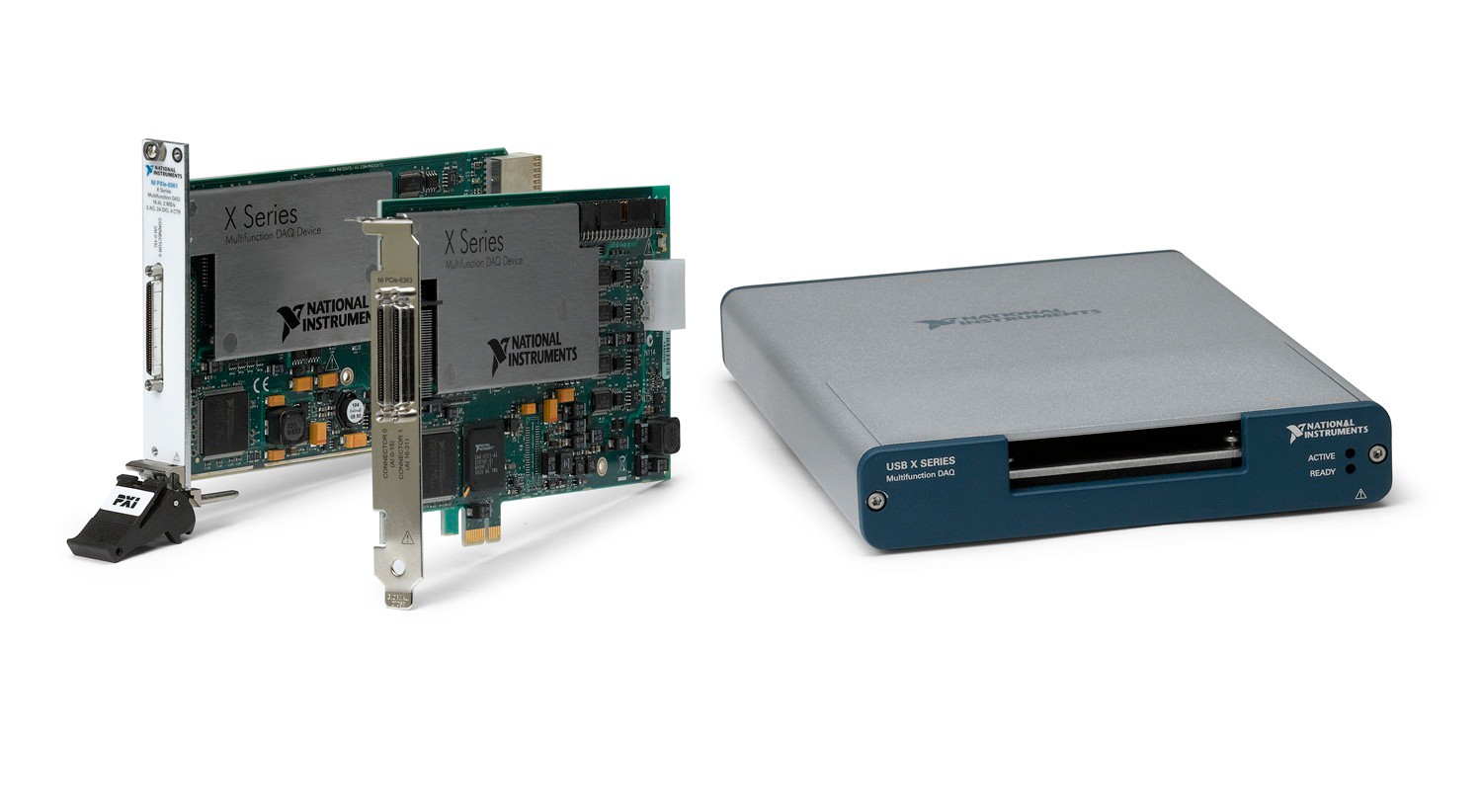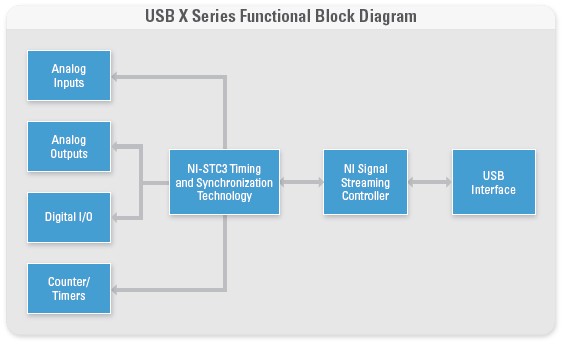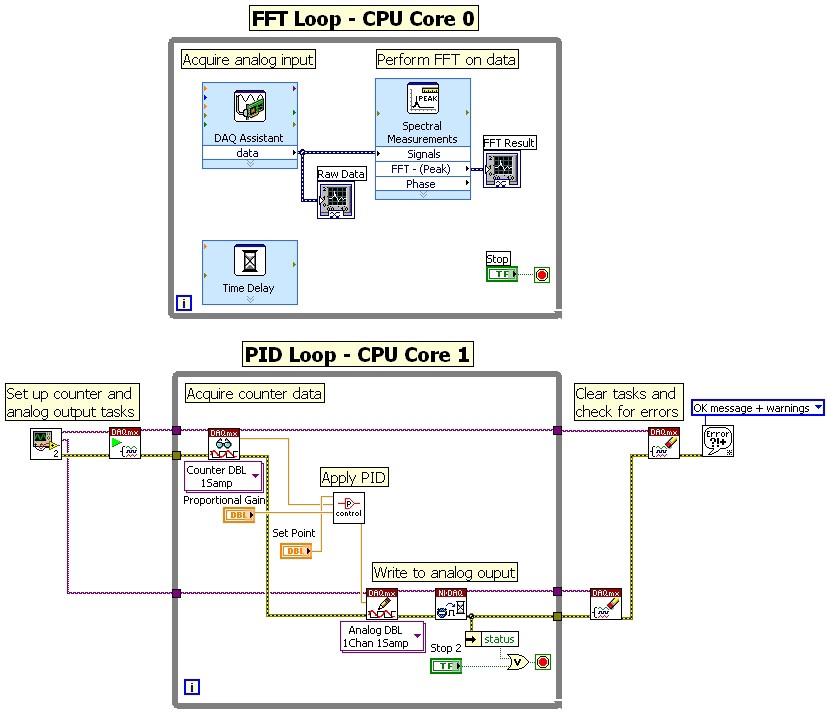What is NI X Series?
Contents
- Product Overview
- Selecting the Right Bus for Your Application
- X Series Technologies
- NI-STC3 Timing and Synchronization Technology
- High-Speed Bus Interfaces
- Parallel Processing on Multicore PCs
- Conclusion
- Next Steps
X Series devices are the most advanced multifunction data acquisition (DAQ) devices ever designed by NI. They feature enhancements to address the needs of the most demanding test, measurement, and control applications.
Available for USB, PCI Express, and PXI Express, each X Series device includes analog I/O, digital I/O, and four 32-bit counter/timers.
X Series offers a new level of excellence for PC-based multifunction I/O. Devices include NI-STC3 timing and synchronization technology, NI Signal Streaming technology for USB and a native interface to PCI Express, and multicore-ready driver software.
Product Overview
Figure 1. NI offers X Series devices for USB, PCI Express and PXI Express.
NI offers a broad range of X Series devices, from low cost to high speed with simultaneous sampling. Table 1 summarizes the models you can choose from and their key specifications.
| Module | Analog Inputs | Max AI Sampling Rate | Aggregate AI Throughput (All ch) | Analog Outputs | Digital I/O | DIO Max Clock Rate |
|---|---|---|---|---|---|---|
| NI USB-6341 | 16 | 500 kS/s | 500 kS/s | 2 | 24 | 1 MHz |
| NI USB-6343 | 32 | 500 kS/s | 500 kS/s | 4 | 48 | 1 MHz |
| NI USB-6346 | 8 | 500 kS/s | 500 kS/s | 2 | 24 | 1 MHz |
| NI USB-6351 | 16 | 1.25 MS/s | 1 MS/s | 2 | 24 | 10 MHz |
| NI USB-6353 | 32 | 1.25 MS/s | 1 MS/s | 4 | 48 | 10 MHz |
| NI USB-6361 | 16 | 2 MS/s | 1 MS/s | 2 | 24 | 10 MHz |
| NI USB-6363 | 32 | 2 MS/s | 1 MS/s | 4 | 48 | 10 MHz |
| NI USB-6356 | 8 Simultaneous | 1.25 MS/s/ch | 10 MS/s | 2 | 24 | 10 MHz |
| NI USB-6366 | 8 Simultaneous | 2 MS/s/ch | 16 MS/s | 2 | 24 | 10 MHz |
| NI PCIe-6320 | 16 | 250 kS/s | 250 kS/s | 0 | 24 | 1 MHz |
| NI PCIe-6321 | 16 | 250 kS/s | 250 kS/s | 2 | 24 | 1 MHz |
| NI PCIe-6323 | 32 | 250 kS/s | 250 kS/s | 4 | 48 | 1 MHz |
| NI PCIe-6341 | 16 | 500 kS/s | 500 kS/s | 2 | 24 | 1 MHz |
| NI PCIe-6343 | 32 | 500 kS/s | 500 kS/s | 4 | 48 | 1 MHz |
| NI PCIe-6351 | 16 | 1.25 MS/s | 1 MS/s | 2 | 24 | 10 MHz |
| NI PCIe-6353 | 32 | 1.25 MS/s | 1 MS/s | 4 | 48 | 10 MHz |
| NI PCIe-6361 | 16 | 2 MS/s | 1 MS/s | 2 | 24 | 10 MHz |
| NI PCIe-6363 | 32 | 2 MS/s | 1 MS/s | 4 | 48 | 10 MHz |
| NI PXIe-6341 | 16 | 500 kS/s | 500 kS/s | 2 | 24 | 1 MHz |
| NI PXIe-6361 | 16 | 2 MS/s | 1 MS/s | 2 | 24 | 10 MHz |
| NI PXIe-6363 | 32 | 2 MS/s | 1 MS/s | 4 | 48 | 10 MHz |
| NI PXIe-6356 | 8 Simultaneous | 1.25 MS/s/ch | 10 MS/s | 2 | 24 | 10 MHz |
| NI PXIe-6358 | 16 Simultaneous | 1.25 MS/s/ch | 20 MS/s | 4 | 48 | 10 MHz |
| NI PXIe-6366 | 8 Simultaneous | 2 MS/s/ch | 16 MS/s | 2 | 24 | 10 MHz |
| NI PXIe-6368 | 16 Simultaneous | 2 MS/s/ch | 32 MS/s | 4 | 48 | 10 MHz |
Table 1. You can choose from a broad range of channel count, sampling rate and bus options.
Selecting the Right Bus for Your Application
When it comes to choosing the bus that is right for your application, there are several factors that you should consider. For instance, USB is ideal for applications that require portability and plug-and-play functionality. PCI Express and PXI Express offer easy multidevice synchronization and the highest possible bandwidth and lowest latency.
Table 2 summarizes some important factors for selecting between USB and PCI Express or PXI Express.
| USB | PCI Express and PXI Express | |
| NI-STC3 technology |  |  |
| Concurrent analog, digital, and counter operations |  |  |
| Portability |  | – |
| Plug-and-play operation |  | – |
| Integrated signal connectivity |  | – |
| High bandwidth | – |  |
| Low latency | – |  |
| LabVIEW Real-Time support | – |  |
| Multidevice synchronization | – |  |
Table 2. Consider these important factors for selecting between USB and PCI Express or PXI Express.
X Series Technologies
To extend the functionality and flexibility of a multifunction device far beyond what was possible with previous generation devices, X Series devices incorporate three major technologies:
- NI-STC3 timing and synchronization technology
- High-speed bus interfaces for USB and PCI Express/PXI Express
- Parallel software execution
NI-STC3 Timing and Synchronization Technology
All multifunction data acquisition hardware requires onboard timing circuitry to control analog, digital, and counter I/O lines, and the evolution of timing ASIC technology occurred over decades. The X Series DAQ family features new NI-STC3 technology that provides four enhanced counters, a 100 MHz timebase, and additional options for I/O timing and triggering.
Four Enhanced Counters
The new NI-STC3 technology in X Series takes counters to the next level, offering four 100 MHz counters with 32-bit resolution. Not only are there four counters on a single X Series device, but operations that on previous devices required two counters can now be done with a single counter channel. For example, if you were controlling a stepper motor, you would often need to generate a finite number of digital pulses and, in the past, this would involve using one counter to continuously generate pulses and a second counter to gate pulses being sent to the motor. The NI-STC3 counters could accomplish this task with a single counter, meaning a single X Series device could control up to four stepper motors.
100 MHz Timebase
The onboard timebase of any data acquisition device acts as the internal heartbeat that drives all digital circuitry. Everything from sample clocks to trigger lines uses the timebase as an onboard reference to generate clock frequencies and latch digital edges. NI-STC3 technology uses a new 100 MHz timebase for all analog and digital timing, which is five times faster than any previously released DAQ device from NI. This means that sampling frequencies are five times more accurate, and analog triggers can respond within 10 ns of a trigger condition being met.
Independent Timing Engines for Analog and Digital I/O
Advanced timing and triggering functionality on data acquisition devices has often relied on onboard counters and complex signal routing to achieve specialized hardware-timed performance. NI-STC3 technology offers completely independent sample clocks and triggers for each different group of I/O on a multifunction device. Retriggerable acquisitions, for example, involve waiting for a trigger condition to be met, taking a finite number of samples, and then immediately rearming the trigger for the next acquisition. Using driver software function calls to rearm the trigger risks missing the next trigger due to software latency; therefore, the best possible performance requires a hardware-timed approach. In the past, counters were the only way to implement hardware-timed retriggering, and so counters would be used to generate a retriggerable pulse train, which was then internally routed to act as the analog input sample clock.
Also, with NI-STC3 technology on new X Series DAQ boards, analog channels no longer require the use of counters to implement retriggerable acquisitions and triggers can independently rearm themselves without software intervention. Another example of new independent timing capabilities is the new dedicated clock for acquiring or generating hardware-timed digital waveforms.
High-Speed Bus Interfaces
X Series devices incorporate several enhancements for high-throughput applications; that is, those applications that pass large amounts of data to and from the device and PC memory. X Series devices for USB include NI Signal Streaming technology. X Series devices for PCI Express and PXI Express include a native interface to PCI Express for maximum throughput and low latency.
Patented NI Signal Streaming Technology
USB X Series devices include patented NI Signal Streaming technology, which uses message-based transfers and device-side intelligence to ensure high-speed, bidirectional data transfer over USB.
Figure 2. USB X Series include NI-STC3 technology for advanced timing and triggering, and NI Signal Streaming technology to maximize USB bus throughput.
By taking advantage of this technology, NI is able to make simultaneous sampling multifunction USB devices for the first time ever with two devices that can sample at 1.25 MS/s and 2 MS/s on each of eight analog inputs and include 32 or 64 MS of onboard memory. The high sampling rates on all channels make these devices ideal for portable ultrasonic test and transient recording applications. Long-term, continuous operation of these devices will be dependent on the host PC, sampling rate, and channel count.
Native PCI Express Interface
With the introduction of PCI Express and its integration into the PXI Express standard, the data bottlenecks that once existed in a measurement system are disappearing. In contrast to the shared 132 MB/s bandwidth of PCI, PCI Express provides dedicated serial lanes to each device and a theoretical bandwidth of 250 MB/s in each direction.
Some data acquisition devices use a bridge-based implementation to convert a PCI design into PCI Express, which limits the bandwidth to that of PCI and introduces additional latency. X Series instead provides a native x1 (“by one”) PCI Express and PXI Express interface with the full PCI Express bandwidth. You can use PCI Express X Series devices in PCI Express slots from x1 up to x16.
Figure 3. You can use X Series for PCI Express in any PCI Express slot, from x1 to x16.
X Series also includes eight DMA channels to stream data directly between the device and PC memory without CPU interaction or additional programming effort. These eight channels provide parallel data streams for the analog I/O, digital I/O, and all four counter/timers. With an expanded 127 sample FIFO for each of the four 32-bit counters, it is now possible to perform buffered counter operations, such as event counting or generating a PWM output, at much faster rates than prior devices.
As is true with most internal buses, PCI Express has very low latency, making it ideal for closed-loop control applications. X Series devices also expand the capabilities of hardware-timed single point performance on all the subsystems of the device.
Parallel Processing on Multicore PCs
To fully take advantage of the parallel hardware subsystems on a DAQ device, you need high-performance driver and application software.
The driver software for X Series is NI-DAQmx, which provides a simple, consistent API among all of the measurement and generation types. NI-DAQmx is multithreaded, which means that you can develop applications that segment processing of your measurement and generation tasks into separate threads. You can call into NI-DAQmx from several programming environments, including NI LabVIEW, NI LabWindows™/CVI, C/C++, Visual Basic 6, and .NET.
The easiest way to interface with NI-DAQmx and optimize your data acquisition application for use on a multicore computer is with LabVIEW. You can create a While Loop for each measurement task, and LabVIEW automatically divides your application into multiple threads. Your operating system can then manage the optimal execution of these threads among one or more CPU cores. For instance, you could create a While Loop for proportional integral derivative (PID) control that runs on one core and a While Loop that processes a fast Fourier transform (FFT) on another.
Figure 3. You can process your DAQ device I/O on separate CPU cores by using parallel While Loops in LabVIEW.
PCI Express and PXI Express X Series devices require NI-DAQmx Version 9.0 or later, and USB X Series devices require NI-DAQmx Version 9.2 or later. NI-DAQmx 9.0 introduces two powerful features:
- Fast, easy data logging. You will frequently want to log your acquired data to disk for post-processing or trending purposes. With NI-DAQmx, it is now possible to log data to Technical Data Management Streaming (TDMS) measurement files by adding a single “DAQmx Configure Logging” VI to your NI-DAQmx task. This method of writing TDMS files is also extremely fast; preliminary benchmarks indicate disk writes are possible at more than 1 GB/s.
- Multidevice tasks for X Series. For high-channel-count applications with X Series, you can easily synchronize multiple devices. For PCI Express X Series, you need to connect them with a Real-Time System Integration (RTSI) cable. For PXI Express X Series, the modules can synchronize to each other over the timing and triggering buses on the PXI Express backplane. NI-DAQmx 9.0 introduces multidevice tasks for X Series, which means that you create a single set of measurement code that includes two devices, and NI-DAQmx manages the sample clock sharing automatically.
Figure 5. NI-DAQmx driver software makes synchronizing two or more X Series devices easy with multidevice tasks.
Conclusion
With advancements in timing and triggering, bus transfers, and data processing, X Series devices represent the most technically advanced DAQ devices ever designed by NI. By taking advantage of the latest PC technologies, including PCI Express and multicore processors, it is now possible to create a cost-effective measurement and control system that is truly parallel from signal to software.
Next Steps
- See X Series specifications and pricing
- Existing data acquisition system? View these considerations for porting to X Series
The mark LabWindows is used under a license from Microsoft Corporation. Windows is a registered trademark of Microsoft Corporation in the United States and other countries.




